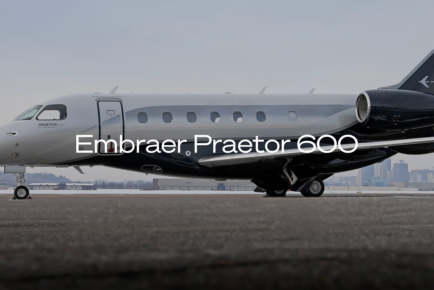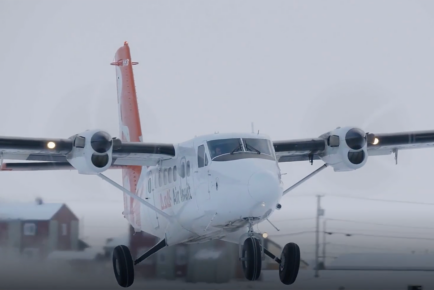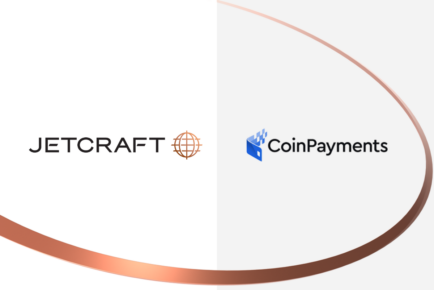AvBuyer Magazine, May 2016
by Ken Elliott
Helping you understand the technology, integration and advances of aircraft avionics and equipage, Ken Elliott concludes a five-part series on aircraft connectivity, this month with a brief history followed by an insightful look to the future.
Last month we addressed the expanding use of walk-on Personal Electronic Devices (PEDs) on board aircraft, and how they reduce the need for permanently installed equipment. PEDs also allow the user to seamlessly function with the same device and familiarity as experienced on the ground.
While this capability is profound in itself, let us take a step back and look at the wider aspect of future aircraft connectivity.
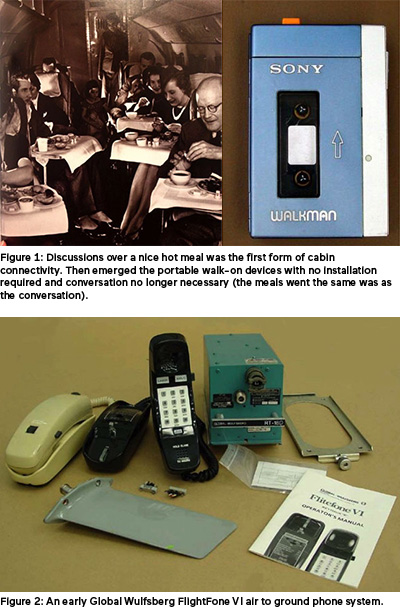 First, a Short History
First, a Short History
Many years ago, I recall a customer requested cabin entertainment that was beyond a cassette deck and cabin speaker(s), the standard at the time. Satisfying his requests was more involved than simply adding essential passenger address (PA) override, or a headset provision at the CEO chair. We had to call in the big guns from the local car audio shop…
The expert they sent had never seen the inside of a Gulfstream II (or even a Cessna 172), but his contribution to our ‘modern’ audio-visual system, with its sub-woofers and multiple input sources, was an eye opener to us seasoned avionic gurus.
Somewhere in the 1990s, cabins became more than airborne passenger-lounges and began to move into zoned, functional workspaces for the busy executive. Technologically inclined and enlightened aircraft owners elevated expectations, and bigger long-range jets provided the capable platform for the new ‘office in the sky’.
Later, our avionics shop made another quantum leap when approached by an aftermarket Gulfstream owner who ran one of America’s leading home entertainment businesses. The owner’s knowledge of system control caused us to pause and reflect on aircraft cabin control in a way that was far beyond the audiovisual. (Meanwhile, and in parallel to our own efforts, avionic suppliers were finding ways to remotely control cabin lights, cabin environment, audio-visual and much more, all from single touch screen armrest controls.)
Aside from the cabin, aircraft connectivity reached to the outside world. Before satellites were available for commercial aviation use, aircraft relied on other means to transmit messages, and in some cases data, across continents and oceans. Aircraft, weighed down with bulky high-frequency communication systems, struggled to make contact and stay on frequency. Selcal (selective calling) enabled enroute air traffic control to stay in touch with aircraft, even when the HF frequency was not being monitored by the pilot. Volmets provided audio weather information as an added feature.
I recall, as an avionics technician, the woes of tuning Sunair HF radios to long wire antennas, enabling aircraft to stay in touch while flying over the endless untapped forests of central Africa.
About the same time as satellite technology was first making its way into aircraft, companies like Aircell (now GoGo) were ‘experimenting’ with analog voice, air to ground, telephone systems. Those early days of aircraft ‘telephones’ were marked by serious hand-off problems related to ground stations and their line of sight relationship to aircraft position and altitude. When Magnastar products entered the market and competition increased, phone and corresponding early data systems multiplied, with increased sophistication and reliability.
A true revolution occurred with the onset of Iridium satellites with their low earth orbits and low ‘by the minute’ call costs, all with seamless hand-off coverage. This allowed Aircell and others to take off in the world of cabin connectivity. Communication was now expanding into digital data, visual and the internet, all in line with developments back in the home and the office.
I was fortunate to be one of the first to install the Iridium broadband and see the excitement of an aircraft operator able to function, like we still do today, in the local coffee shop with our portable devices, at relatively affordable rates (…well, maybe not quite such low cost, so fast or as much data…!)
Some incidental side benefits of the new affordable satellite communication were the ability to receive weather, to share real time aircraft performance and to track the aircraft’s position.
Aircraft Connectivity: A Future Imagined
Step forward, past the present that we have covered over the previous four articles, and join us on a magical journey into tomorrow…
To begin with, the reader must face the long-term reality of widespread autonomous flight, with less use of ‘humans in the loop’ and without reliance on a two or three-person crew, or eventually any pilot onboard. Initially, of course, unmanned will still require a ground pilot, but eventually that need will expire.
As the use of wireless, satellite and air-to-ground technologies expands into the cockpit, the reliance on ‘humans in the loop’ will cautiously fade away, but not without resistance. In essence, the two connectivity advances will merge over time. Also they will merge with a similar transition taking place on the ground and centered on Air Traffic Control.
The Internet of Things (IoT) covers a virtual universe of wireless activity, one part of which is transport and a sub part of transport is aviation. The Internet of Aviation Things (IoAT) is the world of tomorrow for our industry. Because of the limits of data storage at end nodes (such as your aircraft), imagine instead that your aircraft is connected, real time, 24 hours a day, to its own personal cloud. A cloud that streams back and forth all the data it, and the world it connects to, will need.
Our future Cloud may have 4 partitioned areas (Cloud 1, 2, 3 and 4). Let’s deal with each in turn…
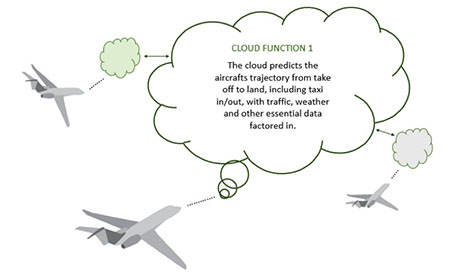 Cloud 1: Essential Data (Trajectory)
Cloud 1: Essential Data (Trajectory)
The aircraft, as a vehicle, can perform without a cloud – especially with on-board pilot(s) – so focus is on the activities of the aircraft once it’s in motion. It needs to know where to go and what is its optimum trajectory along the way. That, for convenience, will be provided by a Predictive Trajectory Cloud. The aircraft’s performance will be dictated by this predictive trajectory.
The predictive information from the cloud mimics 4D Performance Based Navigation (PBN), but includes all aspects of weather and all phases of flight, from taxi-out to taxi-in. It accounts for the flight plan, air traffic control, other aircraft, incidents, NOTAMS, runway conditions, aircraft weight and balance, pilot inputs, and so on.
The flight is time-based, so there will exist a continual loop of data streaming from the aircraft to the cloud regarding its performance, thus the cloud can accurately predict, and then advise the future trajectory back to the aircraft. Aircraft will be projected to arrive at specific 3D sky points at fixed times.
The jewel in the crown of the predictive trajectory will be the avoidance of weather. The IoAT will have enabled, and weather-sensing technologies will have evolved, to allow a subset of predictive weather to the trajectory formula.
The technologies now emerging for seeing the runway surface during all low visibility conditions will ensure VFR-like activity in and around the airport, at all times. Extreme storm, snow and ice weather will be sufficiently predicted to allow a proper assessment of route and trajectory, prior to taxi out. If already enroute, adequate predictions will also provide for a new route and trajectory. Despite what we hear, weather is the most significant disrupter in our national airspaces, and weather prediction still requires significant ‘off-aircraft’ technology innovation.
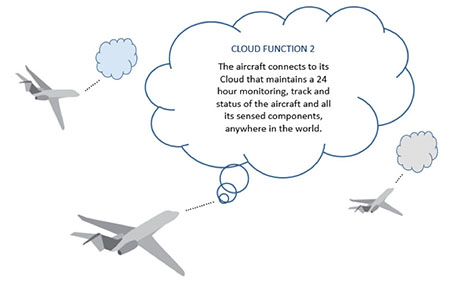 Cloud 2: Secondary Data (Surveillance)
Cloud 2: Secondary Data (Surveillance)
While the aircraft can perform and project on its trajectory, it still needs to be tracked and monitored. Imagine a cloud that streams the aircraft’s status 24 hours a day, in the air and on the ground.
Tiny RFID-like devices will be embedded throughout the fuselage, monitoring the performance and status of thousands of components. Streaming data will morph into ‘data on demand’ where, autonomously, data will be streamed in either direction, only when demanded. This will free-up valuable bandwidth for even more IoAT functionality.
The aircraft will be tracked along its route, and the cloud will retain all recorded data for any emergency that could arise. Meanwhile, company headquarters, operations and maintenance will all have valuable access, in real time, to the same Tera or even Peta Bytes of data.
Because the surveillance of aircraft performance and component level systems is continuous and deeply diagnostic, maintenance tasks such as RVSM and Pitot Static recertification will take place during every trip, without the need for on-ground validation. Systems such as navigation will be constantly tracked for signal reliability and accuracy at the Cloud 2 level.
Cloud 2 will, in essence, be a virtual aircraft in itself. The existing flight data recorder, cockpit voice recorder, emergency locator and other devices, will exist in the cloud and not be physical on-board equipment. Search and Rescue and NTSB personnel will access all the data they need from this ‘live cloud’.
Subject to de-identification, Cloud 2 data will be shared with those who wish to improve airspace efficiency. Branches within the FAA NextGen office, for example, are currently taking that approach; a quick look at the FAA ‘Performance Snapshots’ website will reveal how far they have progressed to date.
The emergence of system-wide performance monitoring and, for operators, the tracking of an aircraft’s annual performance, is about to bloom into a whole new industry, as everyone catches up and realizes the ROI benefits.
As the airspace becomes increasingly populated with unmanned autonomous flight platforms, the need to see and avoid will increase and the ability for conflict being predicted and resolved in the cloud will also be required. Equipment such as TCAS, ADSB and TAWS will disappear as predictions of trajectory take over. The cloud, in concert with other clouds, will have been tracking all the aircraft in the neighborhood.
Furthermore, the cloud will have access to a virtual 3D world updated every hour or so to account for obstacle changes. This ability of the cloud to see and avoid will be built into the final trajectory data, streamed to the aircraft. Hence, the system will provide real-time Collision Avoidance.
Importantly, the Four Clouds will all be connected as one and then in turn, connected to other systems of information. Data such as all aircraft movements, 3D terrain, live weather, live airport and runway conditions, and many other common data streams will be the same and available to all aircraft. This is what we call a virtual airspace, a central place that mimics the real world ‘almost live’ and where all aircraft connect.
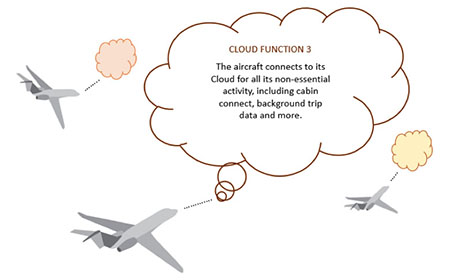 Cloud 3: Non-Essential Data
Cloud 3: Non-Essential Data
You will be able to walk on your aircraft with your personal device and continue what you were doing on the ground, whatever it may be. Connect your PED to approved on-board resources and discover everything you need to know about the trip.
Conference in to your company’s survey team in the remote islands of Indonesia, then relax with a full length 3D movie played on your virtual reality goggles: Cloud 3 will provide all of this capability, as well as activities we have not yet even imagined.
Pilots, using a plethora of applications, will have the capability to enhance their flight with nondistracting activities. Predictive trajectory options may be explored, useful destination data reviewed, in-flight purchase transactions completed, predictive weather analyzed and airport-runway status reviewed. Non-essential voice, as audio, will be digitized and streamed, as data, in the continuum of system-wide information.
Pilots will conduct real-time telephony over the same data stream, not as separate voice calling. CPDLC and FANS are early steps toward this architecture. Furthermore, through voice recognition technology, pilot communications will be recognized and digitized at the source.
Finally, Cloud 3 will accommodate the demands of social media networking. Today professionals struggle with the role of social networking in the world of business. As we watch the two merging, it becomes apparent that the word ‘social’ no longer implies a casual chat between friends. The whole world is becoming interactive, and the role of social media in aviation operations is still in its infancy.
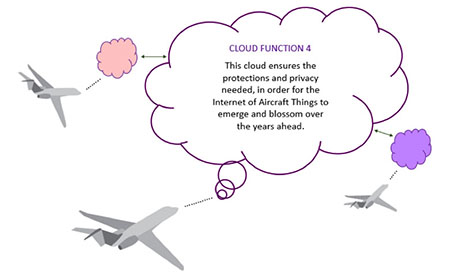 Cloud 4: Critical Data (Security/Back-Up)
Cloud 4: Critical Data (Security/Back-Up)
There is no point in the existence of Clouds 1-3 without proper security and privacy. Intertwined, these two aspects of protection will always be considered critical to overall connectivity.
Company operations will determine what is private and needs to be protected—or if shared, de-identified. Sharing will occur at greater frequency, but flight departments will be very cautious and conservative as they move into this area.
Protection from hackers and scammers will continue to grow exponentially, and firewalls of layered protection will grow to isolate critical aircraft systems from any outside interference.
Equally, everything needs to be backed up and partitioned. Cloud 4 will be a semi-permanent virtual aircraft, able to replace any data lost and impossible to be tampered with or damaged. Clouds will back up Clouds to ensure the continuous availability of service, providing the confidence and assurance needed for the IoAT to develop.
Summary
Connectivity, as seamless wireless data, will transform aviation. Far into the future, it will depopulate the aircraft of redundant on-board equipment and eventually make way for unmanned ATC as well as the need for a pilot (or at least as we understand those needs today). Much of the aircraft’s equipment and functionality will be virtual in a cloud, or ‘cloud of clouds’. Smart ‘on demand’ streaming will maximize data use and speeds.
The IoAT will stream so much data in multiple directions to multiple destinations, it will be the equivalent of a permanently connected highway, steering truckloads of packaged data, via hubs and connectors. This creates a virtual aircraft, as well as another virtual back-up aircraft.
The ‘virtual aircraft’ will control the performance and 4D trajectory of the physical aircraft and its payload. The virtual aircraft will host the lifetime memory of the physical aircraft’s experience and allow the instantaneous connectivity of its passengers to their office, home or anywhere else.
Are you looking for more articles on avionics? Visit www.avbuyer.com/articles/category/business-aviation-avionics/
❯ Ken Elliott is a highly-respected industry authority on avionics as a member of the NextGen Advisory Council sub-committee and Technical Director, Avionics at Jetcraft. Contact Ken via [email protected] or www.www.jetcraft.com.
This article was written by Ken Elliott, Jetcraft Avionics – Technical Director, for AvBuyer Magazine. It was published in the May 2016 issue. Click here to view the Digital issue of the May AvBuyer or to view Archived editions.
Some Recent Industry Connectivity Updates
- Satcom Direct and Universal Weather & Aviation recently paired up and bundled together flight planning with data link services.
- Bombardier and Lufthansa Technik have teamed to provide Challenger 300 operators an upgrade to their cabin management systems.
- Rockwell Collins’ Fusion CMS/IFE is now available for Falcon 50EX operators through 328 Design out of Germany. Duncan Aviation collaborated with 328 Design.
- Twenty-two is the number of Bombardier Global and Challenger aircraft cabin management upgrades, completed by Jet Aviation out of St. Louis, using Rockwell Collins’ Venue system.
- Bombardier will offer the SmartSky 4G LTE-air to ground system to many of its in-service customer aircraft.
- Constant Aviation has added the Embraer Legacy 650 to its existing Wi-Fi STC using a Satcom Direct router.
- EASA has issued a Notice of Proposed Amendment (NPA) to revise cabin interior requirements of CS-25 (certification specifications for large airplanes).
- ViaSat and Eutelsat will be partnering to expand Eutelsat’s current broadband service and launch a new consumer retail service in Europe.
SIGN UP FOR OUR MONTHLY JETSTREAM RECAP
Don't miss future Jetstream articles. Sign up for our Jetcraft News mailing list to receive a monthly eblast with links to our latest articles. Click to join the 1,800+ subscribers on our mailing list.


